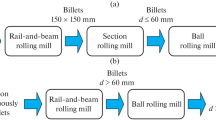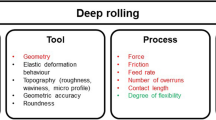Abstract
The deformation behaviour of a hot rolled micro-alloyed steel bar of grade 38MnVS6 was examined using an FEM model during the initial passes in a blooming mill, as a function of three different pass schedules, roll groove depth, collar taper angle and corner radius. The simulations predicted the effective strain penetration, load, torque, fish tail billet end shapes, and metal flow behaviour at a chosen temperature, mill rpm and draft. The model predictions were validated for typical groove geometry and a typical pass schedule. Lower collar taper angle, lower corner radius and higher depth of groove in hot rolling enabled achievement of higher strain penetration, higher mill load and lower fish tail formation. The present study establishes the capability of the model to improve the internal quality of the rolled billet as measured by effective strain which was corroborated to the rolled bar macrostructure and microstructure. The model enables yield improvement by the choice of draft to minimise fish tail losses. The surface quality is improved by the ability to avoid fin formation that occurs at certain conditions of rolling. Thus, the groove geometry, roll pass schedule and rolling mill parameters and temperature can be optimised for best product quality and yield.




















Similar content being viewed by others
References
Wasatowski Z 1969 Fundamentals of rolling 1st ed., Pergamon Press, pp. 25–150
Mori K, Osakada K and Oda T 1982 Simulation of plane-strain rolling by the rigid plastic finite element method. Int. J. Mech. Sci. 24: 519–527
Robert W L 1983 Hot rolling of steel, 1st ed. Markel Dekker, pp. 1–50
Stahalberg U and Goransson A 1986 Heavy reduction by means of ‘Non Bite rolling’ including some observation on work piece shape. J. Mech. Working Technol. 12: 373–384
Duan X and Sheppard T 2001 Prediction of temperature evolution by FEM during multi-pass hot flat rolling of aluminium alloys. Modelling Simulation Mater. Sci. Eng. 9: 525
Biswas S, Joseph J, Gutierrez H and Kiefer B V 2003 User-oriented three-dimensional finite element modelling of high speed bar and rod rolling. In: Proceeding of 45th iron & steel society mechanical working and steel processing conference
Hong H, Kang Y, Feng C and Chen X 2003 Three dimensional thermo mechanical coupled FEM simulation for hot continuous rolling of large diameter mandrel bar. J. Mater. Sci. Technol. 19: 228–230
Byon S M, Kim S I and Lee Y 2004 Predictions of roll force under heavy- reduction hot rolling using a large-deformation constitutive model. Proc. Inst. Mech. Eng. B 218: 483–494
Mróz S, Jagieła K and Dyja H 2007 Determination of the energy and power parameters during groove-rolling. J. Achievement Mater. Manuf. Eng. 2: 59–62
Stefanik A, Szota P and Dyja H 2009 Numerical modelling of the microstructure during 50 × 20 MM flat bars rolling process. Arch. Metall. Mater. 54: 589–596
Motallebi S R 2010 Investigation of influence parameters on the hot rolling process using finite element method. In: Proceeding of 2nd international conference on engineering optimization, pp. 332–338
Tomas Kubina, Miroslav Kucera and Rostislav Kocur 2010 Mathematical simulation of bar rolling with refined friction coefficient. Rožnov pod Radhoštěm, Česká Republika
Shevchenko D V, Saraev D Y, Nesterenko D L and Borovkov A. 2011 FEM study of metal rolling in grooved rolls. In: Proceedings of the 8th European LS-DYNA users conference
Licheng Y, Jinchen J, Jinxiang H and Liwei N 2011 Prediction of process parameters on stress and strain field in hot rolling process using finite element method. Inf. Technol. J. 10: 2406–2412
Nalawade R S, Date P P, Mahadik K N and Cheekatla V S K 2011 Control of end defect on rolled bar. Proceedings of the International Conference on Technology of Plasticity, pp. 61–66
Nalawade R S, Date P P, Mahadik K N, Cheekatla V S K, Balasubramanian V and Singh R 2012 A novel method to reduce end crop loss on rolled bars. Steel Tech. J. 6: 57– 66
Xuetong Li, Lei Cao, Minting Wang and Fengshan Du 2012 Groove design and microstructure research of ultra-fine grain bar rolling. Model. Numer. Simul. Mater. Sci. 2: 67–75
Nalawade R S, Puranik A J, Balachandran G, Mahadik K N and Balasubramanian V 2013 Simulation of hot rolling deformation at intermediate passes and its industrial validity. Int. J. Mech. Sci. 77: 8–16
Aksenov S A, Chumachenko E N, Logashina I V and Kubina T 2015 Numerical simulation in roll pass design for bar rolling. Metalurgija 54: 75–78
British Steel Corporation 1975 Roll pass design. Chorley & Pickersgill Ltd., pp. 20–70
Manohar P, Kyuhwan L, Rollett A D and Lee Y 2003 Computational exploration of microstructural evolution in a medium C-Mn steel and applications to rod mill. ISIJ Int. 43: 1421–1430
Werke M, Kristoffersen H, Haglund S, Svensson L and Nord A 2008 Predicting residual stresses and hardness of a critical component using a combination of numerical and empirical methods. Steel Res. Int. J. ISSN 1611-3683, 2: 812– 819
Sen-dong G, Li-wen Zhang, Jin-hua R, Ping-zhen Z and Yu Z 2014 Constitutive modelling of dynamic recrystallization behaviour and processing map of 38MnVS6 non-quenched steel. J. Mater. Eng. Performance 23: 1062— 1068
Hadasik E, Jedrusik D and Kawalla R 2004 Comparison of the flow stress functions determined in the hot compression and torsion tests. Acta Metall Slovaca 10: 271–278
Author information
Authors and Affiliations
Corresponding author
Rights and permissions
About this article
Cite this article
NALAWADE, R.S., MARJE, V.R., BALACHANDRAN, G. et al. Effect of pass schedule and groove design on the metal deformation of 38MnVS6 in the initial passes of hot rolling. Sadhana 41, 111–124 (2016). https://doi.org/10.1007/s12046-015-0457-4
Received:
Revised:
Accepted:
Published:
Issue Date:
DOI: https://doi.org/10.1007/s12046-015-0457-4




